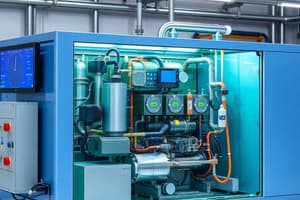Podcast
Questions and Answers
Which of the following is NOT considered a non-renewable fuel?
Which of the following is NOT considered a non-renewable fuel?
- Animal waste (correct)
- Petrol
- Coal
- Natural gas
Which type of fuel is characterized by leaving a residue after combustion?
Which type of fuel is characterized by leaving a residue after combustion?
- Liquid fuels
- Solid fuels (correct)
- Gasoline
- Gaseous fuels
What are secondary fuels primarily derived from?
What are secondary fuels primarily derived from?
- Solid fuels without combustion
- Animal and agricultural wastes
- Natural fuels through chemical processes (correct)
- Renewable resources
What process leads to the formation of fossil fuels?
What process leads to the formation of fossil fuels?
Which of the following fuels exist in liquid form at room temperature?
Which of the following fuels exist in liquid form at room temperature?
What gas is liberated when acids react with sodium bicarbonate in a soda-acid fire extinguisher?
What gas is liberated when acids react with sodium bicarbonate in a soda-acid fire extinguisher?
What are the components of a soda-acid fire extinguisher?
What are the components of a soda-acid fire extinguisher?
Carbon dioxide supports combustion.
Carbon dioxide supports combustion.
The chemical reaction of the soda-acid fire extinguisher can be summarized as: 2NaHCO3 + H2SO4 → Na2SO4 + H2O + ______↑
The chemical reaction of the soda-acid fire extinguisher can be summarized as: 2NaHCO3 + H2SO4 → Na2SO4 + H2O + ______↑
Which of the following is NOT a condition necessary for combustion?
Which of the following is NOT a condition necessary for combustion?
What property of acids is utilized in soda-acid fire extinguishers?
What property of acids is utilized in soda-acid fire extinguishers?
What is the ideal characteristic of a fuel in terms of calorific value?
What is the ideal characteristic of a fuel in terms of calorific value?
Flashcards are hidden until you start studying
Study Notes
Classification of Fuels
- Fuels are classified based on renewability, physical states, and sources.
On the Basis of Renewability
- Renewable Fuels: Derived from animal and agricultural wastes; sustainable and non-depleting.
- Non-Renewable Fuels: Available in limited quantities and can be exhausted; examples include CNG, petrol, and coal.
On the Basis of Physical States
- Solid Fuels: Bulky, requiring large storage space; produce ash or residue upon combustion, e.g., wood and coal.
- Liquid Fuels: Exist as liquids at room temperature; leave no residue after combustion, e.g., kerosene, petrol, and diesel.
- Gaseous Fuels: Naturally in gaseous form at room temperature, e.g., CNG and hydrogen.
On the Basis of Sources
- Primary Fuels: Found in their natural form; examples include animal and agricultural wastes, wood, and coal.
- Secondary Fuels: Produced from natural fuels through physical and chemical processes; examples include water gas and producer gas from coke, and coal gas from coal.
Fossil Fuels
- Formed from decomposed remains of plants and animals over millions of years; includes coal, petroleum, and natural gas.
- Coal forms from buried plant remains, while petroleum and natural gas originate from marine organisms.
- Fossil fuels are crucial energy sources, providing heat and light for cooking and powering engines.
Soda-Acid Fire Extinguisher
- Soda-acid fire extinguishers utilize the reaction between acids and compounds like potassium carbonate or sodium bicarbonate to produce carbon dioxide.
- Carbon dioxide gas, generated during the reaction, is non-combustible, making it effective for fire suppression.
- The extinguisher consists of a glass bottle filled with sulphuric acid, placed above sodium bicarbonate solution in a sealed container.
- When the extinguisher is triggered, the glass bottle breaks, allowing the acid to react with the bicarbonate solution, releasing carbon dioxide.
- The chemical reaction involved is:
- 2NaHCO3 + H2SO4 → Na2SO4 + H2O + 2CO2↑*
Combustion and Fire Characteristics
- Combustion is an exothermic reaction, meaning it releases heat during the process.
- Essential conditions for combustion include the presence of a combustible material, oxygen (air), and a sufficient heat source.
- A candle flame has three distinct zones: luminous (yellow), non-luminous (blue), and a temperature gradient region, each serving different functions in the burning process.
- Fire can be extinguished effectively by depriving it of air, a method often employed in various fire-fighting techniques.
- The effectiveness of a fuel is determined by its calorific value—the amount of heat generated per unit mass.
- Ideal fuels should possess high calorific values, while also being practical in terms of storage, transport, and handling.
Studying That Suits You
Use AI to generate personalized quizzes and flashcards to suit your learning preferences.





